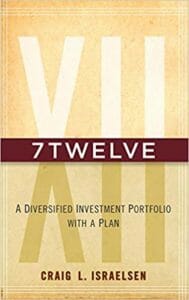Written By: Trish Savage, M.S., AFC®
 7TWELVE – A Diversified Investment Portfolio with a Plan, by Craig Israelsen, PhD
7TWELVE – A Diversified Investment Portfolio with a Plan, by Craig Israelsen, PhD
AFCPE core skills include guiding clients and offering strategies as they work to achieve their financial goals. This book review is offered as a suggested resource for those with an AFC® accreditation who may need to educate a client on asset allocation and diversification that can affect an investment portfolio, especially one targeted for retirement*.
Craig Israelsen, in his book 7TWELVE – A Diversified Investment Portfolio with a Plan gives the basics and specific key elements for building a well-diversified investment portfolio. His method, or as he describes, a recipe, is his “guide to building a portfolio that provides an ideal blend of risk-controlled performance”. In a nutshell, his recipe includes developing a portfolio with mutual funds in 7 asset classes and Twelve underlying mutual funds. He shows how this level of planned and balanced diversification optimizes performance and minimizes risk.
The seven core asset classes included in his recipe are: U.S. Stock, Non-U.S. Stock, Real Estate, Resources, U.S. Bonds, Non-U.S. Bonds and Cash; each with one to three underlying mutual funds. For example, the U.S. Stock’s asset class has three underlying mutual funds: Large, Medium-sized and Small companies; the Non-U.S. stock class has two underlying funds: developed and emerging companies. All twelve underlying mutual funds are to be balanced (or equally weighted) with each having 8.33 percent of the portfolio (for those under age 50). Though rebalancing the funds to the equal percentages can of course occur monthly or quarterly, Israelsen recommends the less often the better and that annual rebalancing gives the best results.
The book compares his plan’s results with a typically planned portfolio multiple times, explaining investment terms along the way. He discusses topics such as measuring volatility and risk, diversification, correlation between types of funds and the effects, rebalancing, investing in growth vs. value funds, preservation of capital and withdrawal of funds during retirement at a sustainable rate. His plan has a different percentage mix for different age categories throughout the life cycle: twenty-to-fifty, fifty-to-sixty, sixty-to-seventy and those seventy and older. A chart in chapter seven shows the suggested allocation percentages per fund during those different stages in life. Chapter fourteen covers how to assemble a portfolio with specific fund names like those from T Rowe Price, Vanguard, and Schwab in each class. I suggest you check out this book to find out what is in his last chapter that offers “3 Secrets + 4 Principles” on how to reach 7Twelve Perfection.
If you are tempted to buy the book, please note that a revised edition of this book may come out mid- 2020, though the principles will be the same.
*Our client meetings typically begin with a discussion on financial goals and spending personality that may lead to revealing a client’s risk level and saving for goals. Assets discussed are possibly tied to an investment portfolio. As Accredited Financial Counselors® we are not certified to advise clients on specific investments to buy or sell. To lawfully advise in this area, we must hold other certifications such as a Certified Financial Planner (CFP®) or be registered with a state as a Registered Investment Adviser (RIA), etc. Depending on clients served and the state a counselor practices in, the state may issue an exemption (if applied for) which allows advising for those who have only an AFC® certification.